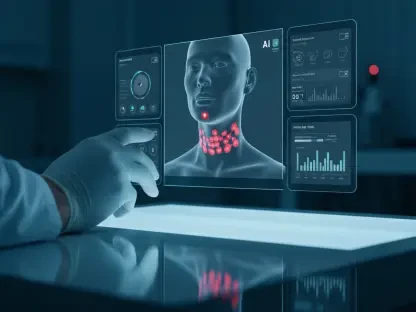The concept that “prevention is better than cure” has been an essential directive in healthcare for centuries. This age-old wisdom finds new relevance as advances in artificial intelligence (AI) make early detection and intervention more achievable. AI technologies promise to reshape patient care by providing innovative solutions that intervene before acute symptoms even develop. This leap in healthcare efficacy relies heavily, however, on integrating dedicated infrastructure capable of meeting the unique demands of the healthcare industry. Specifically, vertical clouds—industry-specific cloud platforms—have emerged as a promising tool to tackle the challenges of AI integration, including security, compliance, and data processing speed. Vertical clouds hold the potential to address these industry-specific challenges, promising to revolutionize how AI technologies are applied in healthcare. The path to unlocking AI’s full potential in this domain hinges on creating dedicated environments that can facilitate quick and secure AI-based solutions.
The Power of Vertical Clouds
Vertical clouds are designed to specifically meet the nuanced requirements of distinct industries, and ihttps://unsplash.com/photos/woman-standing-indoors-82BHTkmkDfUn healthcare, this includes addressing critical concerns like data security, regulatory compliance, and operational speed. These industry-specific clouds serve as AI-ready platforms, streamlining the integration of AI technologies through standardized protocols suited to the healthcare landscape. The significance of this approach is evident in the implementation of AI applications for stroke detection, among other innovative uses. For instance, the utilization of near-infrared sensors demonstrates the potential of AI to derive meaningful insights by analyzing and recognizing subtle data patterns. Challenges, however, persist, hindering the broad application of AI in healthcare settings. The primary impediments stem from stringent data access requirements and operational speed, both of which vertical clouds aim to mitigate. By offering a unified infrastructure, vertical clouds promise to overcome these hurdles, paving the way for AI’s transformative impact.
AI technology holds the potential for profound changes in healthcare, yet its widespread application encounters significant roadblocks. Fragmented data systems, coupled with complex regulatory requirements like GDPR in Europe and HIPAA in the US, make the integration of AI technologies cumbersome and confusing. Vertical clouds tackle these obstacles by embedding necessary security and compliance frameworks, which ensure safe and regulated data management. This integration technique supports healthcare providers in maintaining accountability and transparency while allowing seamless data flow and processing. Increased interoperability among healthcare entities facilitates more efficient data usage and operational improvement, underpinning future AI-driven advancements. The strategic advantage of vertical clouds lies in their capacity to provide specialized, compliant platforms that streamline the assimilation of AI within the healthcare industry, fostering innovation with the necessary precision and care.
Overcoming AI Integration Challenges
In healthcare, the integration of AI technologies is fraught with challenges largely due to stringent security and compliance standards. Stringent regulations such as GDPR and HIPAA necessitate meticulous data management practices, often creating complex layers of compliance that can inhibit the swift incorporation of AI solutions. This difficulty is compounded by the existence of fragmented systems and sensitive data storage practices that can bottleneck AI’s potential to revolutionize healthcare. To address these challenges, vertical clouds offer a tailored approach, with built-in frameworks that prioritize data privacy, security, and regulatory adherence. By doing so, vertical clouds facilitate smoother integration paths for AI technologies, which can bolster healthcare operations with cutting-edge solutions while respecting existing legal restrictions.
The improved interoperability facilitated by vertical clouds is instrumental in creating cohesive healthcare environments in which data can be shared and analyzed seamlessly. This capability allows for more efficient processing and utilization of data, offering a notable advantage in timely decision-making scenarios. With embedded compliance frameworks, hospitals and research institutions gain the confidence to handle and analyze sensitive patient information without the fear of breaching privacy laws. This capacity transforms healthcare providers’ ability to deliver enhanced, data-driven services, substantially mitigating the administrative burdens typically associated with AI implementation. By directly addressing the impediments to AI integration, vertical clouds empower healthcare organizations to leverage innovative AI technologies effectively and ethically, ultimately fostering a landscape ripe for groundbreaking advancements in patient care.
The Role of Speed in AI Effectiveness
In the realm of AI applications, particularly those necessitating real-time data analysis, speed is paramount. Despite the benefits offered by vertical clouds, reliance on public cloud infrastructure can lead to congestion and slowdowns, creating a bottleneck that hampers AI effectiveness. For healthcare solutions that depend on immediate data processing—such as emergency stroke detection—the latency inherent in public cloud architectures poses a significant challenge. This scenario underscores the necessity for solutions ensuring rapid data exchange, which is essential for the timely execution of AI-driven decision-making processes. Effective AI integration depends on resolving these speed challenges, paving the way for real-time data utilization in urgent healthcare scenarios.
Interconnection is critical for overcoming the speed barriers that threaten AI applications’ success in healthcare. By facilitating high-speed data exchanges across different networks, clouds, and service providers, interconnection ensures the seamless flow of information that immediate healthcare scenarios demand. Minimizing latency and ensuring secure transactions are integral components of this strategy, allowing for enhanced AI-driven clinical decisions. Internet Exchanges and Cloud Exchanges play a pivotal role by linking AI-enabled healthcare platforms to cloud providers and data centers, sustaining robust data security and compliance protocols. Direct connectivity through these exchanges reduces data-sharing hurdles and provides customizable AI solutions, fostering environments that support specific healthcare requirements like predictive analytics and automated diagnostic tools.
Interconnection as a Key Enabler
The role of Internet Exchanges and Cloud Exchanges is crucial for the development of interconnected infrastructures that facilitate efficient AI operations in the healthcare sector. These frameworks enhance the connectivity between AI-driven healthcare platforms, alongside a consortium of cloud providers, data centers, and research networks. This interconnected setup accelerates decision-making capabilities while upholding stringent data security and compliance measures necessary in the sensitive healthcare industry. The seamless integration facilitated by these exchanges further reduces data-sharing barriers, allowing for more accessible and effective AI deployment.
This integration of networks empowers healthcare providers to leverage AI technologies that support specific needs, such as implementing predictive analytics for chronic disease management or utilizing automated imaging diagnostics for more precise assessments. By facilitating the direct linking of resources necessary for high-speed and secure data processing, these exchanges enable AI-driven healthcare deliverables that were previously hampered by infrastructural limitations. This capability to provide tailored solutions paves the way for further innovations, ensuring that healthcare becomes increasingly predictive, personalized, and data-driven. With increasing reliance on these robust interconnected systems, AI technologies can function at their maximum potential, yielding comprehensive healthcare insights and enhancing patient outcomes through precise, data-based interventions.
Global Adoption Trends
The global landscape shows a growing trend towards the adoption of vertical clouds, with nearly 40% of companies across various industries implementing these specialized platforms today. The healthcare sector stands out as particularly poised to benefit from vertical cloud capabilities, given its extensive data needs and the potential for transformative AI-derived insights. These platforms empower healthcare providers and researchers to extract vital information from data without facing the conventional barriers posed by traditional data-handling methods. The ability to offer healthcare-specific solutions that integrate seamlessly with AI technologies positions vertical clouds as a strategic resource in advancing healthcare’s future landscape.
With vertical clouds, healthcare organizations can foster a shift towards predictive, data-driven medicine, as these platforms allow for the effective utilization of AI to preemptively address healthcare challenges. This adaptability ensures that AI solutions can be customized to meet particular health sector needs, enhancing capabilities in areas like chronic disease management through predictive analytics or improving diagnostic accuracy through automated imaging processes. As vertical clouds become a fixture within the industry, they enable a nuanced approach to data handling that aligns with the goals of modern, proactive healthcare, marking a pivotal shift in how medical professionals engage with ever-expanding datasets and technological advancements.
The Future of AI in Healthcare
The principle that “prevention is better than cure” has been a cornerstone in healthcare for centuries. This wisdom gains renewed significance today as innovations in artificial intelligence (AI) make timely detection and intervention more practical. AI technologies have the potential to transform patient care, offering advanced solutions that act before severe symptoms even appear. Yet, the success of these AI-driven advancements in healthcare largely depends on the implementation of specialized infrastructure tailored to meet the industry’s unique needs. Vertical clouds—or industry-specific cloud platforms—stand out as promising tools to overcome challenges in AI integration such as security, compliance, and rapid data processing. By addressing these specific demands, vertical clouds offer the potential to revolutionize the application of AI in healthcare. The journey to fully harness AI’s capabilities in the field depends on cultivating environments that enable swift and secure AI-based interventions, laying the groundwork for a proactive healthcare approach.









